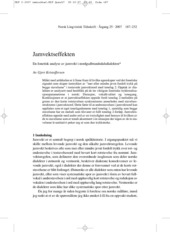Jamvektseffekten En fonetisk analyse av jamvekt i nordgudbrandsdalsdialekten
Peer reviewed, Journal article
Permanent lenke
https://hdl.handle.net/1956/2579Utgivelsesdato
2007Metadata
Vis full innførselSamlinger
Sammendrag
Level stress (Norwegian: jamvekt) is a prosodic pattern found in Norwegian and Swedish dialects which have retained mono-moraic (short) root syllables from Old Norse. In disyllables with accent 2 and short initial root syllable, both syllables perceptually appear to carry some degree of phonetic stress, hence the term level stress. A common description in the dialectological sources is that stress is “more or less evenly distributed across the two syllables”, where we for diachronic and metrical reasons would have expected full stress on the initial root syllable. The goal of the present article is to reveal what level stress is from a phonetic, i.e. perceptual perspective. Based on recordings of speakers of the North Gudbrandsdal dialect in Norway, three properties regarded as relevant with respect to stress realization in Germanic languages are examined: Segment duration, vowel quality and F0-trajectories as realizations of the tonal accent. The main finding of the investigation is that the final syllable of level stress words aligns with the final part of the accent 2 melody in a way that invites the listener to interpret the final syllable as an independent accent 1 domain. At the same time the two syllables together constitute a well-formed accent 2 domain with initial stress. In the absence of a decisive quantitative difference between the two syllables, a level stress word therefore appears as ambiguous with respect to accent placement. Målet med artikkelen er å finne fram til hvilke egenskaper ved det fonetiske signalet som skaper inntrykket av ”mer eller mindre jevnt fordelt trykk på begge stavelsene” i tostavede jamvektsord med tonelag 2. Opptak av dialekten er analysert med henblikk på de tre viktigste fonetiske trykkrealisasjonsparametrene i norsk: Durasjon, vokalkvalitet og tonegang. Konklusjonen er at jamvektseffekten oppstår fordi tonelag 2-melodien på grunn av den korte rotstavelsen synkroniseres annerledes med stavelsesstrukturen i jamvektsord. Dette fører til at andrestavelsen i jamvektsord kan oppfattes som et eget tonelagsdomene med tonelag 1, samtidig som begge stavelsene har en melodi som tilsvarer et fullt tonelag 2-forløp. Jamvektseffekten oppstår med andre ord av en tvetydighet med hensyn til hvilken av de to stavelsene som er tonalt aksentuert i en situasjon der ingen av de to stavelsene kvantitativt peker seg ut som den trykksterke.
